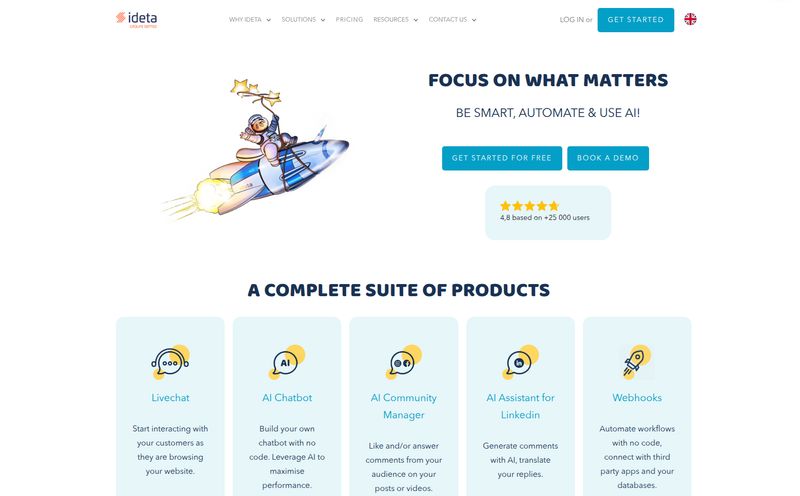Pre-production is chaos. Pure, unadulterated, caffeine-fueled chaos. It’s a storm of spreadsheets that crash, script versions nobody can keep track of, and a thousand tiny details that all threaten to derail your project before a single camera even rolls. I’ve been in those trenches for years, trying to align a creative vision with a client’s budget, and it often feels like you're trying to build the plane while it’s taxiing down the runway.
So, whenever a new tool pops up promising to bring order to that madness, my ears perk up. But my skepticism meter also goes into overdrive. Recently, a tool called Blooper has been making the rounds, billing itself as an “all-in-one pre-production assistant.” It claims it can transform the whole messy process into a “stress-free experience.”
Stress-free? In production? That’s a bold claim. I decided to pull back the curtain and see if Blooper is the real deal or just another piece of shiny tech that looks good but falls apart under pressure.
So, What Exactly Is Blooper?
Think of Blooper as a centralized hub for everything that happens before you shout “Action!” It’s a platform designed to take the most tedious, time-sucking parts of pre-production and automate them using AI. We’re talking about taking a raw script and letting a machine handle the initial breakdown, generate storyboards, and even suggest shooting locations. It’s built for filmmakers, creative agencies, marketing teams, and honestly, anyone who’s ever stared at a 100-page script and wondered, “Where do I even begin?” The whole idea is to get everyone on the same page, from the director to the producer to the client, without drowning in a sea of emails and conflicting Google Docs.
Diving Into the Blooper Feature Set
Alright, let's get into the nuts and bolts. A tool is only as good as its features, and Blooper makes some pretty big promises. I wanted to see how the key functions stacked up against the old-school way of doing things.

Visit Blooper
The AI Script Breakdown: Magic or Just Markup?
First up is the automatic script breakdown. You upload your script, and the platform’s AI chews through it, identifying scenes, characters, props, locations, and other elements. Anyone who’s spent a bleary-eyed night manually highlighting a script with a rainbow of markers knows how monumental this is. It’s the foundation for your budget, your schedule, your entire production plan.
My first thought? This is incredible... if it works. The quality of this breakdown is entirely dependent on the quality of your script. It's the classic GIGO principle: Garbage In, Garbage Out. A well-formatted script will likely yield fantastic results. A hastily written one with inconsistent formatting? The AI might get a little confused. Still, even if it only gets you 80% of the way there, that’s a massive head start.
Instant Storyboards That Don't Look… Instant?
This is the feature that really caught my eye. Storyboarding is crucial for visualizing a project, but it's traditionally expensive and time-consuming. You either hire a storyboard artist (cha-ching) or you wrestle with clunky software that makes everything look like a child’s drawing. Blooper’s promise of “instant storyboards” generated by AI from your script is a potential game-changer. It allows you to get visual concepts in front of your team and clients almost immediately, making it so much easier to get buy-in on a creative direction.
I imagine this is a massive win for pitching new business. Instead of just describing a vision, you can actually show a rough version of it. That’s powerful stuff.
Location Scouting Without Leaving Your Desk
Another huge time sink: finding the perfect location. Blooper’s automatic location scouting analyzes your script’s scene descriptions—a “moody downtown alley” or a “sunny suburban kitchen”—and suggests real-world venues. This is where I have to temper my excitement with a dose of realism. The effectiveness of this feature is going to live or die by the size and quality of its location database. If you’re in a major metro area like Los Angeles or New York, you’ll probably get some great hits. If you’re shooting in a smaller town, the options might be more limited. It’s a fantastic starting point, but I wouldn't fire your location scout just yet.
Moodboards and Pitch Decks on Autopilot
Beyond the core production elements, Blooper also helps with the ‘selling’ part of the job. It can generate moodboards to establish the project's aesthetic and compile everything into a professional pitch deck. This is about streamlining the process of getting a green light. It packages your vision, your plan, and your visuals into one slick presentation. For agencies trying to win clients, this feature alone could be worth its weight in gold, turning a multi-day task into something that takes a fraction of the time.
The Good, The Bad, and The AI
No tool is perfect, right? After looking through what Blooper offers, here's my breakdown of the highs and potential lows. The biggest pro is obvious: it saves an absurd amount of time and, by extension, money. It takes the most repetitive, administrative tasks and puts them on autopilot, freeing up your team to focus on the creative stuff. The collaborative aspect, having one central place for feedback, is also a huge plus, potentially ending the nightmare of conflicting notes from five different people.
On the flip side, there’s likely a learning curve. A tool this comprehensive will take some getting used to before you’re flying. As I mentioned before, you’re also at the mercy of the AI’s interpretation of your script. A poorly written script might not get broken down correctly, which could cause headaches down the line. It's a tool to augment your workflow, not replace your brain entirely.
What’s the Damage? A Look at Blooper Pricing
Here’s the million-dollar question. Or, hopefully, the not-so-many-dollar question. What does Blooper cost? As of my review, Blooper doesn't list its pricing publicly on the site.
This is a pretty common strategy for B2B or enterprise-focused SaaS companies. It usually means they offer custom plans based on team size, feature needs, or project volume. While I always prefer transparent pricing, this approach suggests they're more interested in building tailored solutions for professional teams rather than offering a one-size-fits-all plan. Your best bet is to head over to their site and contact them directly for a quote based on your specific needs.
Is Blooper the Right Co-Pilot for Your Next Project?
So, should you jump on the Blooper bandwagon? My take is this: if you're part of a professional team at a creative agency, a production company, or an in-house brand team that is constantly juggling multiple video projects, then yes, you should absolutely check this out. The potential ROI in time saved and mistakes avoided is massive.
For the solo indie filmmaker running on a shoestring budget, it might be overkill, but even then, the storyboard and script breakdown features could be a lifesaver. Blooper feels like a glimpse into the future of production management, where AI handles the grunt work, allowing creators to do what they do best: create.
Frequently Asked Questions About Blooper
What is Blooper in a nutshell?
Blooper is an AI-powered, all-in-one pre-production management platform. It helps video creators and teams streamline their workflow by automating tasks like script breakdowns, storyboard generation, location scouting, and creating pitch decks.
How does the AI storyboard generation work?
While the exact tech is proprietary, it likely uses natural language processing (NLP) to analyze the descriptions in your script. It then translates those descriptions—like "a wide shot of a character walking in the rain"—into visual representations using a vast library of images and art styles, creating a complete storyboard for your project.
What are the pricing options for Blooper?
Blooper does not have public pricing listed on its website. This typically means they offer customized plans tailored to the size and needs of your team. To get a quote, you'll need to contact their sales team directly through their official website.
Is Blooper secure for sensitive project scripts?
Security is a major concern for any pre-production tool, especially with unreleased scripts. While you should always review the privacy policy of any cloud-based service, platforms like Blooper that cater to professional clients typically employ robust security measures, including encryption and secure servers, to protect intellectual property.
Who benefits the most from using Blooper?
Production companies, creative agencies, and in-house marketing teams that manage complex video projects will see the most significant benefit. The tool's strength lies in simplifying collaboration and automating the time-intensive tasks that are common in professional production environments.
Final Thoughts
The world of video production is getting more complex, not less. The demand for content is higher than ever, and timelines are getting shorter. Tools like Blooper aren't just a luxury anymore; they're becoming a necessity. It represents a smart shift towards working smarter, not harder, by letting technology handle the tedious bits so humans can focus on telling great stories. And in this industry, that's what it’s all about.
References and Sources
- Blooper Official Website - For the most current information and to request a demo or pricing.



